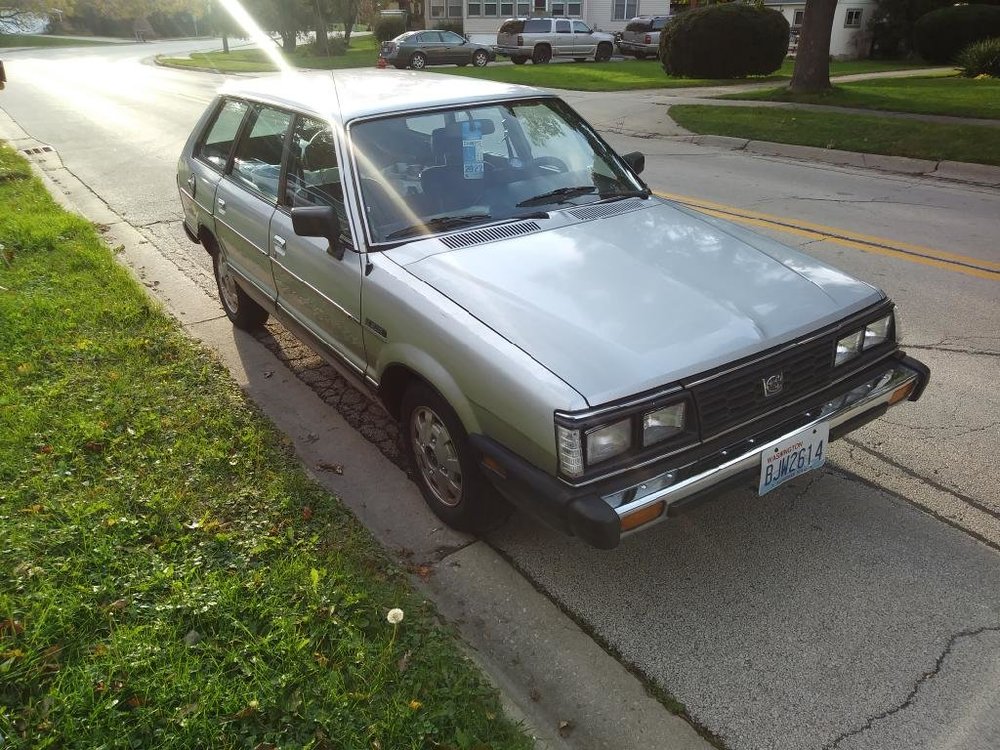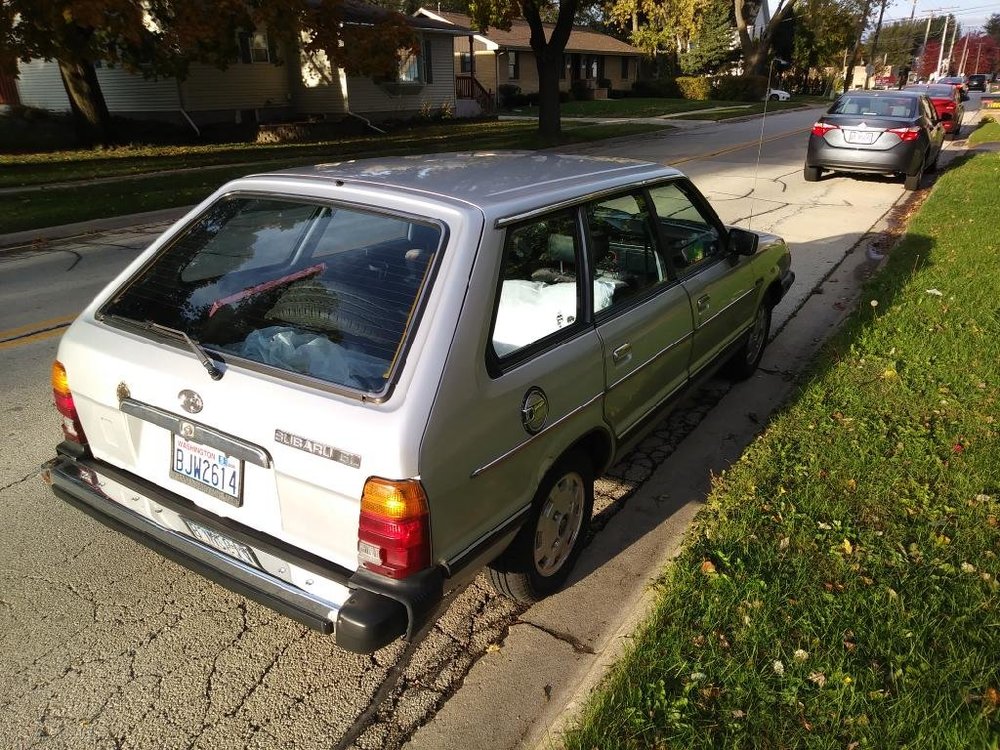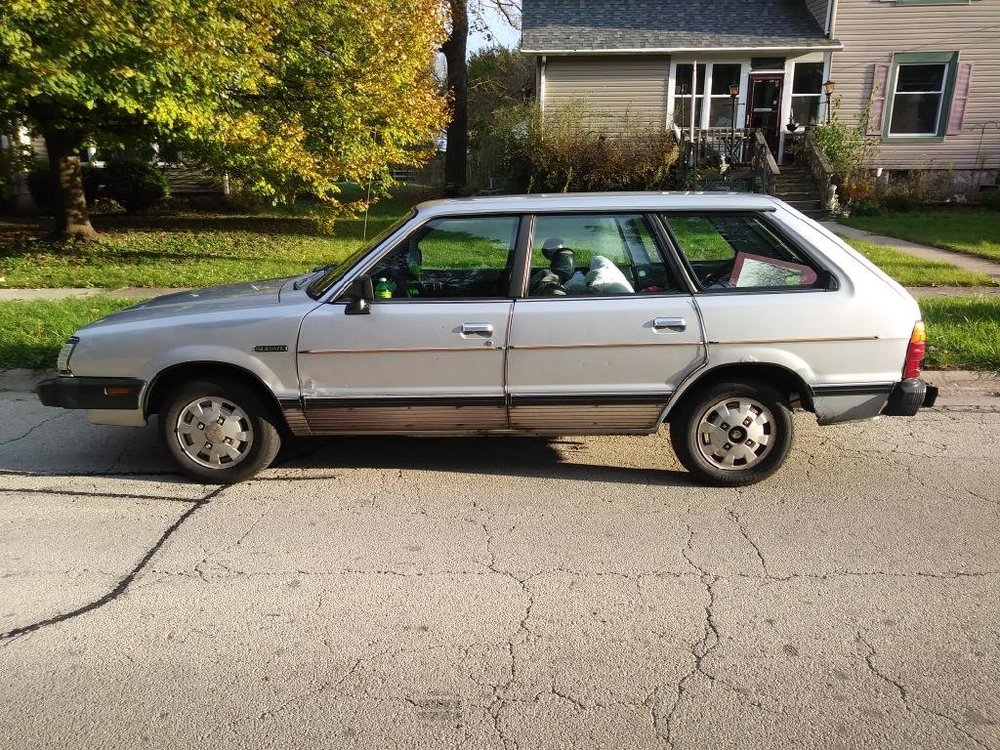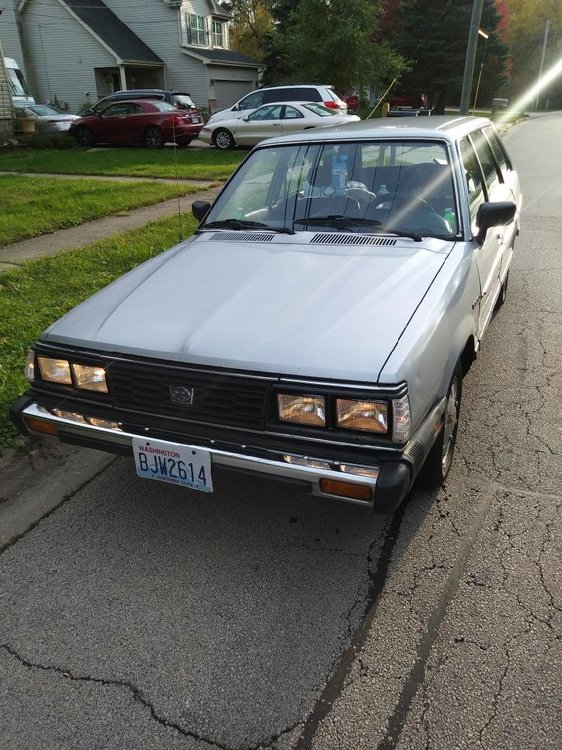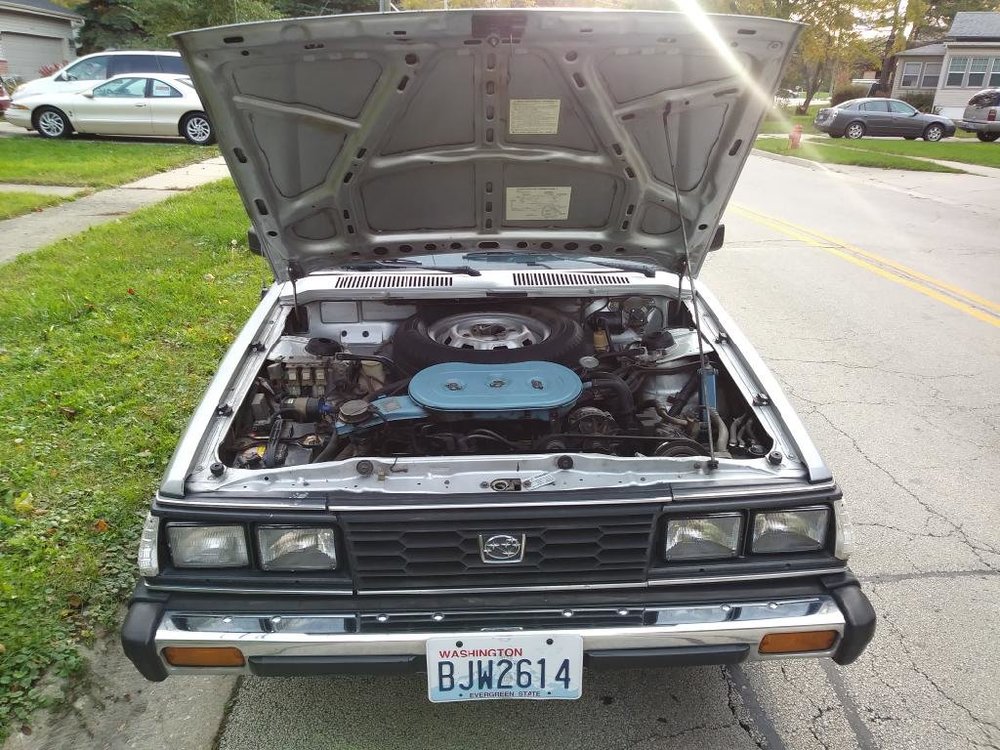Leaderboard
Popular Content
Showing content with the highest reputation on 10/29/19 in all areas
-
Hi there. I've owned 8 Subaru GL's from 1985 to 1999 (they rust terribly here in the midwest and my wife was rear ended in at least 3 of them). So, I was just putzing around Craigslist, and on a lark - I put Subaru GL in the search function. Up sprang a 1984 GL in Yakima, Washington. I made arrangements immediately to buy it (the seller actually responded to me and held onto the car for me). 3 days later, I was in Yakima picking the car up. The condition is stunning - just some surface rust on the rear liftgate and around the bottom of the doors (those will be fixed within the next 2 months). There is a slight oil leak (I had to put 1 quart in over the 2,100 miles I drove). It has a 5 speed (the stick just needs to be tightened up), crank windows, stock stereo (all 4 speakers work), A/C, and a pretty clean interior. The headliner is fine, it just needs to be refreshed (some fading). It drove great through the mountains (I only had to put it into 3rd twice). I even hit a piece of a truck in the road (it was night & 4 different cars hit the same thing), so I used AAA to bring it to a tire shop in Wyoming. Both steel wheels were damaged, but I happened to find the only 13" wheels for this car at a local junk yard (nobody had these wheels for a 5 state area), so I was extremely lucky. Even better, were that these were alloys off of a 1989 GL10. I then took it to a Discount Tire in Cheyenne (which was on my route to Illinois) and wouldn't you know it - they had a set of four 13" tires (P175/70 R13).... & they were in stock no less. The alloys cost me $100, and the tires cost me $280 installed with a road hazard warranty. I then got to Illinois without any issues. I averaged 30 mpg over the whole trip (while averaging 70 mph). In the mountains, it was 24 mpg - on the flat road, it was 34 mpg. The fastest I took the car was 85 mph. Not bad for a 35 year old car with 255,000 miles.3 points
-
One day, just one day, I am going to start measuring the working resistances of various sensors to help establish a ball park figure. Then possibly could feed the ecu what it would like to see if problems improve or change2 points
-
Interestingly enough, my 2002 Forester has very suddenly developed an issue taking fuel.. and of course it happens right when the weather is turning cold.. Have to wonder if a critter has tried to make a nest somewhere it shouldn't have...1 point
-
Usually I can get enough threads through to start a nut. Pull it till it bottoms. Put various spacers, washers, etc and use the nut each time until it's through.1 point
-
1 point
-
I had started to plan out a plug in test panel, with meters, etc to do that kind of thing. Even gathered some of the needed parts. At the same time, ended up collecting enough spare parts that doing swap outs was easier.1 point
-
I recently bought 4 wheels from Hartlaub's. Fair price, good quality, and no BS. All around good experience.1 point
-
The one I had fail was not leaking fuel past the diaphragm. I cheated, and swapped in a spare to "test" it. It ran better with the swapped one. My next step, is I have an adjustable regulator I plan on using. Have to figure the best way to disable the built in one. Then I could do tests and experiment to find the best pressure to run at. When I had the regulator problem on mine, it was starving for fuel. It just started stumbling badly, then quit while I was driving. I got off the highway, and started limping along back roads. Then it quit. I was about to call a tow truck, decided to crank one more time, and it fired. Limped it another mile or 2 to work, checked a few more things, and decided to head home early. It would go with light throttle, die if you tried to get on it at all. I have had my occasional battles with the OBD1 systems in these, but also, very long runs of no trouble at all. These are getting hard to run as daily drivers, because many parts are NLA. Part of why I have 2 that I keep in running condition, so I am not stuck while rebuilding an old part, or searching for a usable used one, or making one. Since you have decent fuel pressure, I suppose the injector might be having as problem. Don't remember - did you take a good look at the intake boot for a crack? If there were one after the MAF, it would be starved for fuel also.1 point
-
I know you said you're making numbers up but to me 40% is wishful thinking. From my experience it's more like 70-80%. I've rebuilt 140 or so of my own cars over the years and found that the only way to sell a rebuilt title car is if its really cheap, wasn't involved in a major accident causing frame damage or airbag deployment, and most important a car that a lot of people want to own. To the OP. Considering the description of the car and your location I would be happy with anything over $28001 point
-
My wife is a Rural Carrier for the Post Office and the 95 and 97 are Right Hand Drive Legacy wagons AWD with EJ22 and automatic. If the tranny oil does not smell burnt, just do a drain and fill. Found this on Valvoline's web site. Is it OK to mix synthetic ATF with a conventional and/or synthetic blend ATF? Yes. Synthetic ATF and conventional fluids are 100 percent compatible with each other. I never expected that, but I trust Valvoline. In the early 70's I read an article that said they had the best 20-50 Racing Motor Oil on the market. Within 5 tests all other racing oils broke down, it took 2 more tests to get the Valvoline to start to break down.1 point
-
Start with any notes the previous owner left that might lead you to his dealer. Then check whether they used synthetic or dino ATF. If no notes, call Subaru of America and they can lead you in the right direction. For example, give them your vin and ask if they did the Tekata airbag recall and what dealer performed the recall. Your Forrester is high enough off the ground that you can get a piece of cardboard and slide yourself underneath to drain the fluid. You'll need a long neck funnel to reach the trany dipstick hole to refill. Buy a 5 pack of crush washers at the dealer though I have been using the same old one for years without leakage. I use genuine Subaru AT fluid. Cost is not that much more than generic. But others here may point you to another brand same as genuine packaged under another name. As others have suggested, after you compare overall cost and your time, decide whether you want to do it yourself. It is dirt simple and you will be done in less time than it will take to drive to the dealer. Oh and if you didn't know, stores like Autozone will take the old fluid to recycle. Don't dump it down the sewer grates. The alligators hate that stuff!1 point
-
1 point
-
That’s both true and not true. First - definitely change the fluid. That EAT trans is a robust beast of a machine, they’re great transmissions. Definitely ensure it has good fluid in it. It can be drained and refilled just like the engine. Draining the trans only removes 4 out of 13 quarts so do it 3 times, driving some between each change, and you’re done. A shop can’t be expected to do all that. But a shop could do 3 trans fluid changes with the next three oil changes in a row and over the course of 1-3 years you’d have your trans fluid change. A shop may not do that because they don’t want to mix old and new fluid. It doesnt matter but they can’t keep track of good trans and ford exploders. Theres other options too but suffice to say this isn’t complicated. 1. Change the trans fluid just like oil. 2. Or have them use the machine. If he won’t, someone else will.1 point
-
The Factory Service Manual recommends changing transmission fluid by using the drain plug and to replace the amount taken out. Then check it idling and hot. Put in a little less than you drained out and start it. Check and add as it warms up. Get a white paper towel and put a drop of fresh ATF on it then pull the dipstick and put that beside it and compare look and smell. Keep in mind, if they put a Full Synthetic in it, it will smell way different than regular ATF. If your transmission, torque converter and cooling lines are completely empty it, would take 9.2 to 10.1 quarts depending on the engine size. On our 95 and 97 4EAT, if I drop the pan and remove the pipe that runs under the filter, I put almost 8 quarts back in it, and it is supposed to hold 8.4.1 point
-
As for the fluid left in the the torque converter you can either do a series of fluid changes in quick succession to rid the trans of old fluid. Or another method that might work is one commonly used by Pajero owners but requires two ppl. Firstly, work out which line on the oil cooler is the OUT line, disconnect this and hang in a collection bucket/pan. Have the second person start the engine and let it run, the pump in the trans will pump out most of the fluid. Once the flow reduces/splutters the first person yells out to the second person to shut off the engine. Drain the rest of the pan, replace filter and refill with the given amount of fluid that came out. Check the levels again after a short drive. Now with all of this, I am yet to do this with our Pajero, but it’s on the list since I don’t know the history of the fluid in the trans. Let me know if this method won’t work or will do detrimental damage to the trans (looks @GeneralDisorder and @FerGloyale) Cheers Bennie1 point
-
"NOT TERRIBLE"?? Is that a comforting diagnosis? Very few of us do the machine method where you change it all out i.e. running a pump and replacing the total volume in a closed loop. Doing the simple drain, yes you will leave some of the old ATF fluid in there but if done correctly, you will not be overfilling it since you will be only replacing as much as you take out, roughly 4+ quarts. Think of it this way, when you exhale, you do not completely empty your lungs of the "old" air and on the next breath, you only inhale as much as you exhaled. You don't over-inhale and explode (if done properly). Get it? The remaining "old" air over successive breaths gradually mixes with the new air and you keep on living. I have 200K on my 2005 and 140K on my 2008 Outbacks and do the simple maintenance like oil and transmission fluid changes myself. I've heard too many horror stories of fast service shops mistakenly draining the transmission and then overfilling the oil! Good thing is that, as you report, it has been dealer serviced so they likely had more done than what was needed to be done and the car is likely in good shape for now. I cringe when I sit at the dealer and listen to the hard sell to unsuspecting customers. You probably can get a history of the maintenance if you know the dealer used and go from there. All that being said, there are many here who are pros, some with real shops, and others like myself that would rather do the simple things and know they were done right instead of sitting at a dealer for hours on end waiting for them to change the blinker fluid and charge me through the nose for the privilege. Depending on where you live in Bklyn, you may not have the luxury of being able to work on your car but if you do, it isn't that difficult to do the simple stuff. Capeesh?1 point
-
Well, the time challenge has been met, successfully! Almost three decades and a half of continous ownership of my Subie, all of them running with this carbureted EA82 which is the original engine, having almost everything original inside it; and these last ten years, the engine has been running with the same timin' belts, coverless! However, my beloved "BumbleBeast" has not reached the 100,000 kilometers' goal with the same timin' belts, yet; thus means that the mileage challenge hasn't been met... So, I decided that I'll let this old timin' kit to stay there, working for few months more; I'll report here as soon as anything new happens regarding the subject; meanwhile I must better find a brand new timin' kit... Kind greetings from Honduras.1 point



